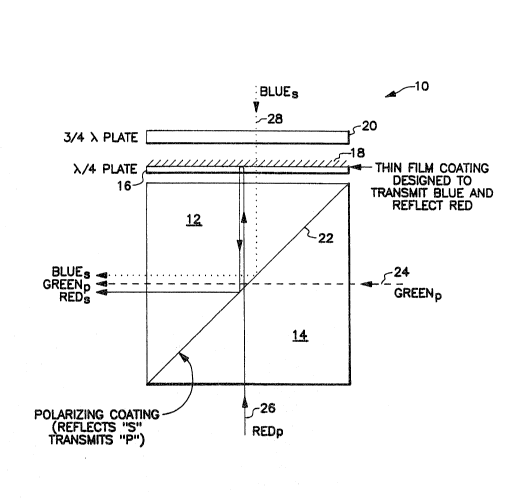Note : Les revendications sont présentées dans la langue officielle dans laquelle elles ont été soumises.
- 7 -
64159-1178
THE EMBODIMENTS OF THE INVENTION IN WHICH AN EXCLUSIVE
PROPERTY OR PRIVILEGE IS CLAIMED ARE DEFINED AS FOLLOWS:
1. A color polarization cube prism for combining/splitting
light, comprising:
a cube, composed of an essentially transparent
material, having first, second, third, fourth, fifth and sixth
sides, and having first and second halves of said cube juxtaposed
at a plane, wherein the first and second halves have boundaries
on the third and fourth sides;
a first optical coating, situated between the first and
second halves;
a first wave retarder proximate to the third side;
a second wave retarder proximate to said first wave
retarder; and
a second optical coating situated between said first
and second wave retarders; and
wherein:
said first optical coating transmits light having a
first polarization and reflects light having a second
polarization;
said second optical coating is a dichroic filter;
said first wave retarder is a quarter-wave plate;
said second wave retarder is a three-quarter-wave
plate;
a first light, having a first polarization, enters the
first side of said cube, passes through said first optical
coating, and exits said cube at the second side;
- 8 -
64159-1178
a second light, having a second polarization, passes
through said second wave retarder, said second optical coating
and said first wave retarder, enters the fifth side of said
cube, impinges the first optical coating and is reflected out of
said cube through the second side; and
a third light, having a first polarization, enters the
sixth side of said cube, passes through the first optical
coating, exits said cube at the fifth side, passes through said
first retarder, impinges said second optical coating and said
third light is reflected by said second optical coating back
through said first retarder and said third light, having its
polarization changed to the second polarization, passes through
the fifth side into said cube, impinges said first optical
coating and said third light is reflected out of said cube
through the second side.
2. A color polarization cube prism for combining/splitting
light, comprising:
a cube, composed of an essentially transparent
material, having first, second, third, fourth, fifth and sixth
sides, and having first and second halves of said cube juxtaposed
at a plane, wherein the first and second halves have boundaries
on the third and fourth sides;
a first film coating between the first and second
halves;
a first wave retarder proximate to the first side;
a second wave retarder proximate to said first wave
retarder; and
- 9 -
64159-1178
a second film coating situated between said first and
second wave retarders; and
wherein:
said first film coating transmits light having a first
polarization and reflects light having a second polarization;
said second film coating is a dichroic filter;
said first and second wave retarders are quarter-wave
plates;
a first light, having a second polarization, enters
said cube through the fifth side, impinges said first film
coating and said first light is reflected by said first film
coating, and said first light exits said cube through the second
side;
a second light, having a second polarization, enters
said cube through the sixth side, impinges said first film
coating, said second light is reflected by said first film
coating, said second light exits said cube through the first side,
said second light passes through said first wave retarder,
impinges said second film coating, said second light is reflected
by said second film coating through said first wave retarder and
said second light, having its polarization changed to the first
polarization, passes through the first side into said cube,
through said first film coating and out of said cube through the
second side; and
a third light, having the second polarization, passes
through second wave retarder, second film coating, first wave
retarder and said third light, having its polarization changed to
- 10 -
64159-1178
the first polarization, enters through the first side into said
cube, passes through said first film coating and exits said cube
through the second side.
3. Apparatus of claim 1 wherein:
said first light is green;
said second light is blue; and
said third light is red.
4. Apparatus of claim 1 wherein:
said first light is blue;
said second light is red; and
said third light is green.
5. Apparatus of claim 2 further comprising:
a first compensator block proximate to the fifth side
of said cube such that said first light passes through said
first compensator block before entering said cube through the
fifth side; and
a second compensator block proximate to said second
wave retarder such that said third light passes through said
second compensator block before entering said second wave
retarder.
6. Apparatus of claim 5 wherein:
said first light is a first color;
said second light is a second color; and
said third light is a third color.
- 11 -
64159-1178
7. Apparatus of claim 6 wherein:
said first color is green;
said second color is blue; and
said third color is red.
8. Apparatus of claim 6 wherein:
said first color is red;
said second color is green; and
said third color is blue.
9. Apparatus of claim 2 further comprising an optical
compensating means proximate to said fifth side of said cube.
